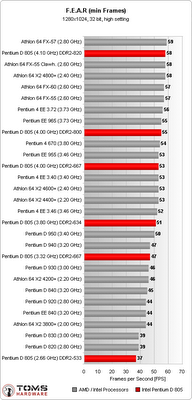An overclocked $130 CPU beating out $1,000 CPU's??

From Toms Hardware:
Conclusion: The 4.1 GHz Dual Core Delivers Peak Performance For Pocket Change
Those who first break this bit of news to their circles of friends can count on some surprised looks - in fact, they might even find their credibility getting questioned! But it is true: a cheap CPU that costs $130 outperforms the fastest processors from AMD (Athlon 64 FX-60) and Intel (Pentium Extreme Edition 965), each of which costs over $1,000.
We bought an Intel Pentium D 805 from a local retail outlet and overclocked it up to 4.1 GHz, even though this part runs by default at just 2.66 GHz. This represents a heretofore unattained clock rate increase of just over 54 %, for which only some additional cooling is required. The secret is in the FSB clock rate, which is raised from 133 MHz to over 200 MHz; the system remains completely stable, because modern motherboards with Intel 9xx chipsets are laid out to handle FSB clock rates of up to 266 MHz. In language that overclocking enthusiasts will love to hear, the Pentium D 805 ascends to the throne as the new King of overclocking, knocking out the AMD Opteron 144.
Here's how the system looks after being reworked: a pumped-up Pentium D 805 outperforms the flagship processors from AMD and Intel that cost more than $1,000. Talk about an investment with an immediate payback!
A short while ago we tested Intel's latest flagship processor, the Pentium EE 965 (Extreme Edition), which costs nearly $1,100 at retail outlets. Even this CPU, which still isn't available at too many locations, has to surrender first place to this stealth candidate. Things look the same for the top-of-the-line AMD processor, the Athlon 64 FX-60, which also fell behind in most of our benchmarking categories.
Our comprehensive benchmarks show that an extremely overclocked Pentium D attains the best performance numbers for nearly every area of activity, including video editing and decoding, audio encoding, office applications, photo retouching and various 3D games. The Pentium D 805 also leads in the multi-tasking arena, where multiple applications execute in parallel. Those who work with complex filters and effects in Adobe PhotoShop CS2 or who use Pinnacle Studio Plus 10 for HD video editing and related rendering and encoding work will also find that this budget $130 CPU is best for their needs. Even gamers can unpack this secret weapon at their next LAN party, without others recognizing that they've got a monster inside their PC case. In any event, the results of doubling the CPU clock rate should earn them some respect!
Windows shows a CPU clock rate of 4.1 GHz. Marks of respect at LAN parties and in your circle of friend should soon follow the acquisition of one of these babies. Right now, nobody offers more capability, either!
In conclusion, we want to say that it's probably wise to also consider the risks with regard to this project. First and foremost, power consumption increases in direct proportion to clock rate: at 4.1 GHz, a fully-loaded system measures out at 210 W, more than twice the nominal specification for this CPU, which Intel pegs at 95 W. High current consumption of 125 A (!) also commands respect, and contributes to high heat output from the switching regulator. That's why we strongly recommend purchase of a high-end CPU cooler and a supplementary fan. Nevertheless, the CPU isn't subject to damage from overheating, thanks to "Thermal Monitor 2", which means overheating leads to clock rate throttling rather than device failure. That's also why the CPU core voltage should be raised only within limits, and more than 1.7 V is decidedly unwise.
Those who find themselves thinking of a new system project as a result of this story should probably get going quickly. The $130 or so a Pentium D 805 will cost you is money well spent in any case. Those who switch away from AMD will also have to spring for a new motherboard (at least $130 for a suitably equipped model) along with 1 GB of quality DDR2 RAM (at least $100). The joy of (re)building such a system adds nothing to the cost, however. For die-hard AMD fans this will mean a change of sides, and possibly politics. But hey, why not, if the results are worthwhile?



0 Comments:
Post a Comment
<< Home